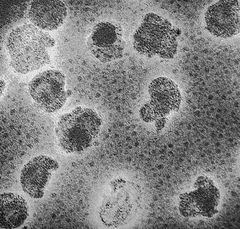Group Group I (dsDNA) | Rank Family | |
 | ||
Similar Corticovirus, Tectivirus, Fuselloviridae, Leviviridae, Cystovirus | ||
Plasmaviridae is a family of bacteria-infecting viruses. Acholeplasma species serve as natural hosts. There are currently only one genus (Plasmavirus), and one species in this family: the type species Acholeplasma phage L2. All species known in this family have been isolated from species in the class Mollicutes.
Contents
This family is poorly studied and little is known about these viruses.
Taxonomy
The family has one genus, Plasmavirus, which has one recognized member. There are five tentative members of Plasmavirus:
Group: dsDNA
Genome
The genome is condensed, nonsegmented and consists of a single molecule of circular, supercoiled double-stranded DNA, 12 kilobase pairs in length. The genome has a rather high G-C content of ~32%. The genome has 14 open reading frames, and encodes at least 15 proteins, of which at least four are structural proteins embedded in the membrane.
Structure
Virions have an envelope, a nucleoprotein complex, and a capsid, with spherical to pleomorphic and head-tail geometries. They are 50–125 nm in diameter with a baggy or loose membrane.
Life Cycle
Viral replication is cytoplasmic. DNA-templated transcription is the method of transcription. The virus exits the host cell by budding. Acholeplasma species serve as the natural host.
Infection
A productive infectious cycle begins before a lysogenic cycle establishes the virus in the infected bacteria. After initial infection of the viral genome the virus may become latent within the host. Lysogeny involves integration into the host chromosome.
